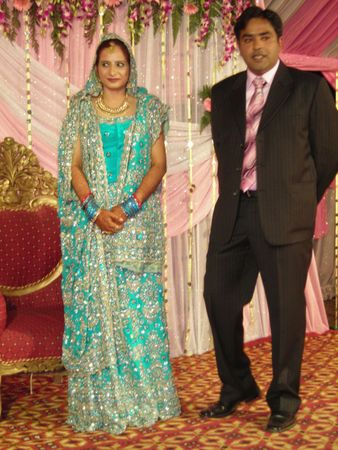Gill Wilson
Residency at Sanskriti Pratishthan
An Indian wedding
Posted by Gill Wilson on 31st January 2007
Friday 26th JanuaryI’ve kind of been out of it for two days with a head cold - and other non specific ailments. I started to think that I’d never get better again. I slept for really long periods which I never do at home. - apart from the fact that a lizard fell onto my bed from the roof with a bump and woke me up !! It’s now lurking under my bed. However, this evening I am feeling better and able to start thinking about some more ideas.
Since my last blog entry we have been to the National Museum of Modern Art, a wedding reception and to the Republic Day Parade, The Museum of Moden Art was mainly an exhibition of Benodebehari Mukherjees’ work - an Indian painter who was inspired by Japanese art.
Jaspreet – our co-ordinator at Sanskriti invited Hanne and myself to a wedding reception of a friends daughter. This was a late reception a couple of days after the event. Indian weddings are quite mystifying to westerners. We dressed for the occaision only to be re-dressed by Jaspreet at her home before going along to the reception. Dupatta , the dress, scarf and salwars (the baggy trousers) being the dress code, Jaspreet has many of these and seemed delighted to be able to dress us ‘properly’. The wedding was quite an affair - we entered through a long draped tunnel which opened into a huge area draped with pink and white fabric. The couple were standing on a stage in a smaller marquee ready to receive guests. We commented on the fact that the bride did not seem excited or happy to be at the event, although later we did discuss the fact that she may have been at events for many days.

It was also an arranged marriage - not unusual apparently even today. Most marriages are arranged by parents, and in general most men and women do not have to concern themselves with finding a partner, a burden they are quite happy to be relieved of. This arrangement also creates alliances between families - royal, political and commercial. As a rule Indian marriages link families, clans and groups. Parents go to great lengths to find compatible partners for their offspring. They look for an ‘attractive and decent character’. Love is regarded as an unreliable basis on which to begin a marriage and is an emotion which is expected to develop over time. Parents do their matchmaking through personal contacts, marriage agencies and newspaper advertisements. Friends with eligible daughters/sons will contact the families. The event we were at was just a small part of the wedding but it must have been very expensive to stage The whole marriage ceremony and dowry must be hugely expensive, displaying the wealth of the men involved (many families take out huge debts and families are ruined as a result of the dowry). The giving and receiving of a dowry is prohibited, but still continues because of its part in social and religious tradition, in family pride and consciousness of social position.
When choosing a partner a light complexion is a most desirable quality in a colour conscious society and many girls are advertised as being a ‘whitish’ colour.
Middle classes seek their own partners but it is still common to hear of arranged marriages. Jaspreet said her son was happy to have her arrange a suitable marriage partner to take the burden off his shoulders.
Visit to Gurgaon
The local shopping centre of Gurgaon has been built over the last five years, It appears to be the ‘future’ of shopping in India. Middle classes shop here as a response to Western advertising. The building is a bad example of shopping malls back home, built alongside call centres and commercial buildings which are faceless and expensive. Small stall holders in the markets in Delhi seem to do a much better job and offer much more choice. I am not sure what will happen over the next few years though the younger Indians obviously see the Mall shopping experience as a contemporary choice but it is at total odds with more established traditional retailing. The M&S store prices (goods same prices as at home) seemed ridiculously expensive compared to normal stores and there seemed no point in buying anything.

Click on image to open QuickTime movie
"ARTIST'S TALK"
Hanne Rysgaard talks to conference during cHAT week at Sanskriti, Delhi, India. March 2007





